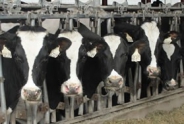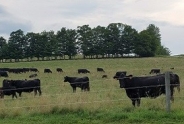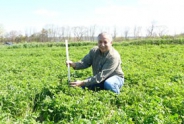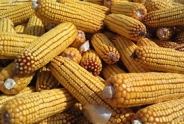Missing corn seed? Consider planting depth and Avipel®
Kevin Ganoe, Area Field Crop Specialist
Central New York Dairy and Field Crops
Birds go to corn fields when the corn is approaching the V1 stage, were you can see the first leaf collar, and start trying to pull the seedling plants out of the ground. If they are successful you will see a seedling plant with no seed hanging on by a few roots, maybe a wilted or dead plant or may be none because it has all but dried up and blown away. You may find parts of the seed coat remaining, easily visible because of seed treatment color and you may seed a depression or divot where the bird worked the seedling around in the ground until it could get to the seed. Sometimes all that is left is this hole or depression but you can see them nicely spaced out where your corn plants should be.
This hole or depression the birds create may also contain a plant that has been cut off as the birds were unable to work the seed out of the ground and they ended up clipping off the green shoot. That clipped green shoot takes less than a day to dry up and in many instances blow away. Get out a knife or a hand spade and dig around the depression you may still find an intact growing point and seed; the growing point is .75 inches below the soil surface and by this time you may see some swelling as the plant starts to form its first nodal roots. You may also find the birds have reached that deep and clipped the growing point off and now the plant is dead.
A first line of defense when it comes to seed loss from birds is making sure that you have corn planted at least 1.5 inches deep and I prefer 2 inches. Maybe 1.5 is considered and ideal "book" depth but here are two real world thoughts. One I have great appreciation for the modern corn planter's ability to place seed exactly 1.5 inches deep but if you are down measuring seed depth seed is usually going to be in and around 1.5 inches, more or less. What you want to be hitting 100 percent of the time is greater than 1.5 inches because anything less that means you have some seed around 1-1.25 inches. Seed that shallow and under the right conditions is easier for the birds to pull up. Aiming for 2 inches will guarantee the majority of your seeds are placed 1.5+ inches.
First year corn planted into sod ground that has worked up nice and loose often gives up corn plants very easy to birds. Worn double disk openers or those that are not adjusted together properly may prevent the seed from reaching the proper depth. Don't be surprised to see patterns in a field where looser soil areas are damaged and more compacted area less so. It may also be hard to get the desired seed depth especially notilling into gravelly soils.
There is another factor when it comes to the "blackbirds" (crows, redwing blackbirds, starlings and grackles) that cause the damage and that is a place for them to roost. Fields that are under bird pressure year after year usually are the right combination of trees available for birds to roost and a food source.
So if you have exhausted getting planter right then consider the use of Avipel® Corn Seed Treatment. Avipel's active ingredient anthraquinone is a chemical found in plants such as rhubarb. When applied to seed and consumed it causes birds stomach distress to the point they will leave the area.
Over the past two years my extension co-workers in Cornell Cooperative Extension and I along with New York State IPM staff like Ken Wise have put out plots where the same hybrid with and without the Avipel®.
The product works very well, so well that when selecting fields that had consistent damage and placing strip trials in those fields the birds once eating the treated strips tended to leave both treated and untreated alone. Don't get any ideas here, I have seen birds figure out the second, fourth and fifth rows of a six row planter were shallow planted and eliminate those rows and not the others planted deeper.
Avipel® Hopper Box Corn Seed Treatment may be purchased and used in NY to reduce grackle and blackbird damage to field and sweet corn. Users must have the 24(c) Special Local Need Registration label in their possession when using this product. (The NY Special Local Needs registration number is SLN NY-170006.) The Special Local Need registration is due to the NYSDEC recognizing that bird damage to corn is a significant issue in NY and that there are no other NY-registered pesticide products to address the situation. Seed pretreated with Avipel® is available from some seed companies so talk to your seeds person to see if that is a possibility if you do not wish to treat your own.
Cost for the hopper box treatment is in the range of $7.50 to $8.40 an acre depending on any discounts. So figuring the cost is equal to the value of 2-3 bushel of corn if you have fields or parts of field that are being wiped out by birds the cost recovery on the Avipel® is very easy to achieve.
Starting with increasing seeding depth should not only lead to less bird damage but also improve corn growth and development in your fields. But if birds are a problem taking corn seeds then consider the Avipel® seed treatment to reduce if not eliminate the damage.
Curtis, P. D., K. L. Wise, J. Cummings, A. D. Gabriel, K. Ganoe, J. J. Miller, M. E. Hunter, K. A. O'Neil, J. R. Lawrence, P. E. Cerosaletti, and Dale R. Dewing. XXXX. Field evaluation of anthraquinone treatment to reduce corn seedling damage by birds. Crop Protection (in review)
Upcoming Events
Ag Workforce Central: Virtual Office Hour
July 9, 2025
Free webinar.
IPM Strategies to Protect Corn and Soybean Seed in NYS
July 22, 2025
Cobleskill, NY
Free event. DEC Credits available
Announcements
Sign Up for Our Weekly E-Newsletter
We send out a bi-weekly e-newsletter that has announcements, upcoming programs, and opportunities for you! Registration is quick, easy, and free. Click here to sign up today!Document and Share Storm Damage
Mother nature has really been difficult over the last few days. Significant damage has been seen throughout NYS. Please let us know what types of damage your farm may have sustained during this time. This could be in the form of property damage, lost power, milk dump due to lost power, loss of livestock, loss of stored feed or growing crops.Farms are encouraged to DOCUMENT AND SHARE any impacts the weather may have had on their home or business. This could include structure damage, crop loss, inventory loss due to power outages, damage to equipment or fencing, and more.
If your farm experienced any sort of damage, please reach out to any of the folks listed below (or all of them). The more impact information that is collected, the greater the likelihood of a disaster declaration which can bring vital emergency support and awareness. The CNYDLFC Team will continue to collect detail and submit to NYSDAM and the EDEN network.
Reporting Weather Related Impacts (For your home or farm business)
- First, ensure that all the people and animals on your farm are safe, and that there aren't any unsafe working conditions created because of the weather (check your structures!). If there's an emergency, call 911 - don't try to manage it all on your own.
- Second, document all negative weather impacts for your farm and their estimated financial cost. Take photos, make estimates, and put it all in a safe place.
- Reach out to your insurance providers - farm, vehicle, crop, etc. to initiate the claim process as needed.
- Then, share your farm's damage with any (or all) of the ag support agencies listed below. We all work together to collect storm damage information and funnel it up to Ag and Markets which can initiate a natural disaster declaration.
- Chenango: 607-334-5841
- Fulton/Montgomery: 518-853-2135
- Herkimer: 315-866-7920
- Madison: 315-684-3001
- Otsego: 607-547-2536
- Schoharie: 518-234-4303
- Saratoga: 518-885-8995
- Erik Smith: 315-219-7786
- Daniela Gonzalez: 315-749-3486
- Ashley McFarland- 315-604-2156
Your county USDA/FSA service center.
- Chenango: 607-334-3231
- Fulton/Montgomery: 518-853-4015
- Herkimer: 315-866-2520
- Madison:315-824-9076
- Otsego: 607-547-8131
- Schoharie: 518-295-8600
- Saratoga: 518-692-9940
Your county farm bureau manager
- Region 3: Bailey Coon: 518-937-0566
- Region 5: John Wagner: 315-761-9770
- Region 6: Natally Batiston: 518-937-0269
- Region 7: Todd Heyn: 518-431-9338
Please let us know how we can help you.
Cash Rent and Custom Harvest Survey
To date, there is limited information available about rental rates and fees for crop harvesting. Farms can use this valuable information for their farm business planning to help improve decision making and profitability.Farmers Can Join MeatSuite For Free!
MeatSuite.com is a free resource provided by Cornell University where NY meat farmers can create a farm profile and list their bulk (wholes, halves, quarters) and bundled (i.e. Grilling Bundle) meat products.Why should farmers join?
1. It's free and easy!
2. Connect with more local customers. In the past year the MeatSuite.com farm directory had 8,300 visits from New York consumers. Farm profiles get as many as 25 views per month from potential local customers. We also spotlight MeatSuite farms on social media and bring attention and purchases to farms through highlights and giveaways.
How do I join?
Farmers can visit https://www.meatsuite.com/farmers/ to create a free farm profile. You must list at least one product for your farm's profile to go live. You'll also have access to Cornell's free Meat Price Calculator, a helpful tool for pricing your meat to make a profit.
While you're on MeatSuite, check out the "Creating Consumer-Friendly Bulk Meats" publication on the log-in page. It has tips on how to create bulk meat products that are easier for first-time buyers to say "yes" to.
If you have any questions as you create your farm profile or products, we're here to help! Please email Matt LeRoux at mnl28@cornell.edu.




